So you’re considering buying a Rolex. Maybe it’s your first luxury watch, or maybe you’ve just never bought a pre-owned luxury watch before. Whatever the case, you want to make sure that you don’t end up with a fake Rolex, and we want to help!
“Rolex is a widely known status symbol, with over 700,000 of its timepieces pumped out annually. It’s also one of the most counterfeited watch brands out there.“
– Megan Willett | Business Insider
The prospect of identifying counterfeits can be intimidating for first-time and seasoned buyers alike. “How do I tell if a Rolex is fake?” is a question that doesn’t have a short, conclusive answer. But if you’re aware of a few fundamentals, it can be a lot less daunting.
General Tips
Tip #1: Always ask for documentation!
Modern luxury watches should always be accompanied by warranty documentation, a good sign of authenticity. A 2-year-old Rolex with no warranty card is a red flag, although it’s common for vintage watches to be missing their box and papers.
Tip #2: Get an expert opinion
It can be difficult to tell the difference between a fake Rolex and a real one without an expert eye. In recent years, criminals have gotten a lot better at creating convincing knock-offs, specifically fake Rolex watches. If you’re considering an expensive watch, you may want a second opinion.
Tip #3: Buy from a trusted and credible dealer!
You’ll do better to buy from an established and trusted grey market dealer with a good reputation and an authenticity guarantee.
More Guides to Spotting Fake Watches:
How to Avoid Buying a Fake Audemars Piguet
How to Avoid Buying a Fake Richard Mille Watch
Commonly counterfeited Rolex models
The general tips above are relevant to any luxury watch brand, but Rolex is really its own beast.
Fake Rolex watches are such a part of the zeitgeist that it seems like they’ve been around forever, but they haven’t: fake Rolex watches weren’t really a thing until the 1980’s. While Rolex has been successful ever since the launch of their Oyster in 1926, they didn’t become “hot” with celebrities until the mid-1960’s, and they only started surpassing Omega in sales (based on chronometer certifications) and leading the luxury watch world around 1970.
Counterfeiters tend to fake the most popular Rolex models of their day, primarily because they are liquid, and these are what they fake most accurately. The most common fake Rolex models floating around are the Datejust, the Submariner, the GMT-Master II and the Daytona.
Very old unpopular Rolex models are very unlikely to have been faked, so if you see a tiny 1940’s Rolex cocktail watch, it’s probably real. However, nowadays there are many fairly convincing fakes of popular Rolex sports models, not to mention “Frankenstein watches” or “super-frankens” which are fakes hobbled together with some real parts. The good news is you should usually be able to tell a fake Rolex from a real one, as long as you’re careful about it. The best place to start is in the details.
Analyze the details
Movement
A good starting point when assessing if a Rolex is genuine is to pay attention to the watch movement. The seconds hand on a real modern Rolex ticks 8 times per second (or 5-6 times per second on a vintage model), creating a “sweeping” visual.
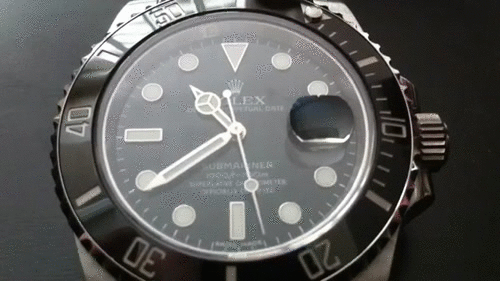
Many fakes use cheap quartz movements, so if it ticks only once per second, unless it’s an “Oysterquartz” model it’s surely fake.
Cyclops
Rolex’s cyclops provides a distinctive 2.5x magnification, and the date should fill up the cyclops window nicely. A lack of magnification is a common indicator of a counterfeit. The date numerals should be nicely centered within the white box; fakes are often off-center, like the two images on the left below. The cyclops on the right is real.
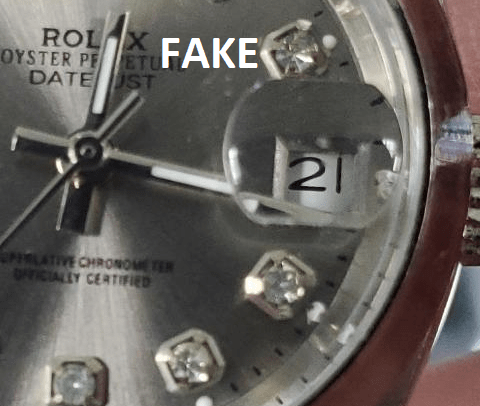
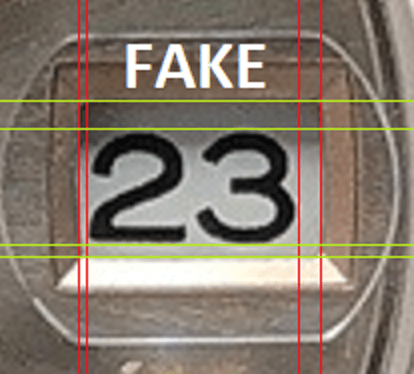
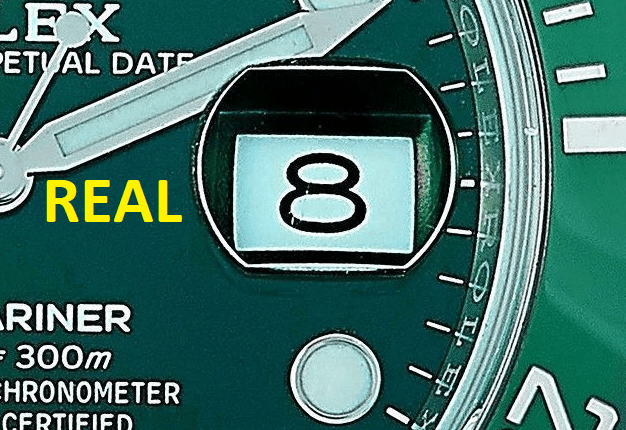
Note that on vintage Rolexes, cheap aftermarket crystals are common, so bad magnification alone isn’t a guarantee of inauthenticity. Also, Rolex notoriously produced a faulty batch of cyclops in about 2015 (it was so bad they had to remove all mentions of “2.5x magnification” from their website), so if you see a watch from that era with a “low-mag” crystal, it could be legit. Also, as noted below, If you’re looking at a Sea-Dweller manufactured before 2017, it should not have a cyclops.
Caseback markings
With few exceptions (such as the Sea-Dweller and Milgauss), Rolex watches do not have specs, logos, or branding on their casebacks. A few vintage ladies’ models actually do say “stainless steel” on the back, and a handful of old Rolexes with certain third-party cases have a crown logo on the caseback, but as a rule, Rolex casebacks should be sterile (blank) aside from personal engravings.
Rolex released three watches with clear casebacks in 2023: The 1908, an updated platinum Daytona, and the “LeMans” Daytona. Four Cellini Prince references made from about 2005-2015 have exhibition casebacks as well, but aside from that, Rolex has always used solid casebacks. Counterfeiters often try to get overly fancy, and go overboard by putting clear casebacks on watches that shouldn’t have them. Although aftermarket sapphire casebacks can be installed on Rolexes, it’s certainly a red flag when assessing authenticity.
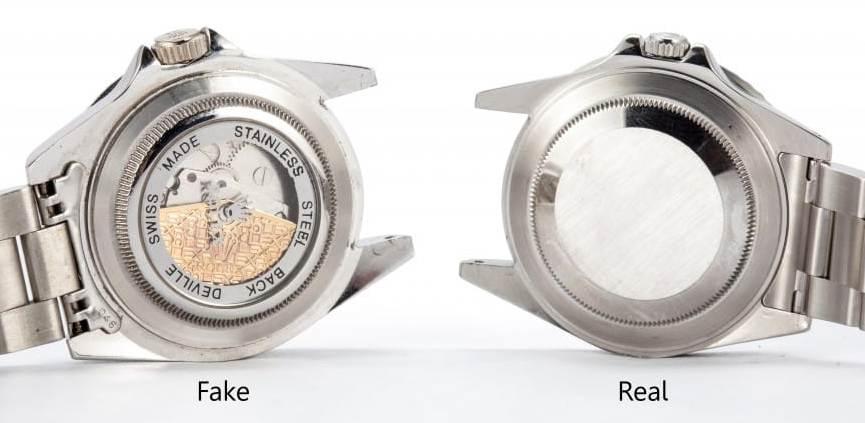
Caseback stickers
For years, Rolex put stickers on their casebacks, apparently as an anti-counterfeiting measure. Naturally, counterfeiters were quick to start faking those too. Although Rolex dropped caseback stickers around 2006, counterfeiters actually kept putting stickers on much longer. So a caseback sticker that looks “too new” can be a red flag. Here’s an idea of what some legit caseback stickers look like:
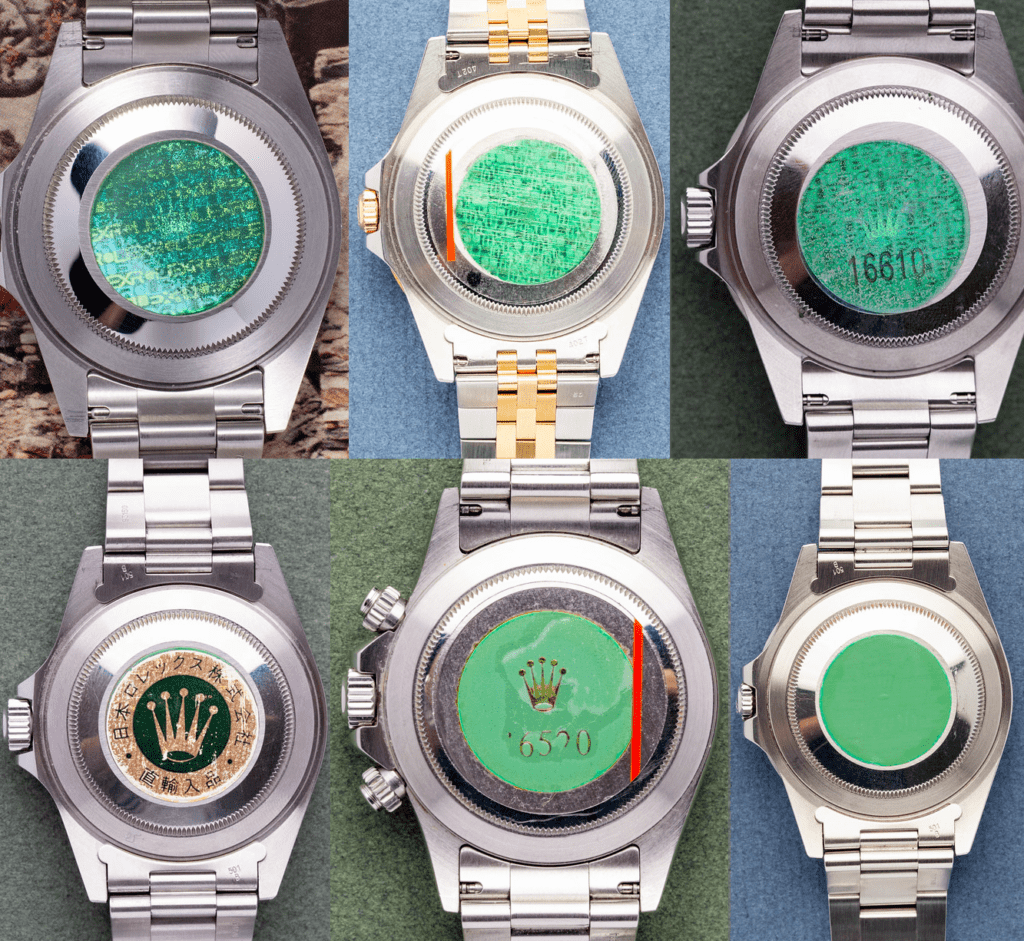
Engraved rehaut
Since 2008, all Rolexes have had the “ROLEXROLEXROLEX” engraving on the rehaut. The serial number should be at 6 o’clock, so if the “ROLEXROLEXROLEX” writing goes all the way around with no break for a serial number at the bottom, that’s a sure sign of a cheap fake.
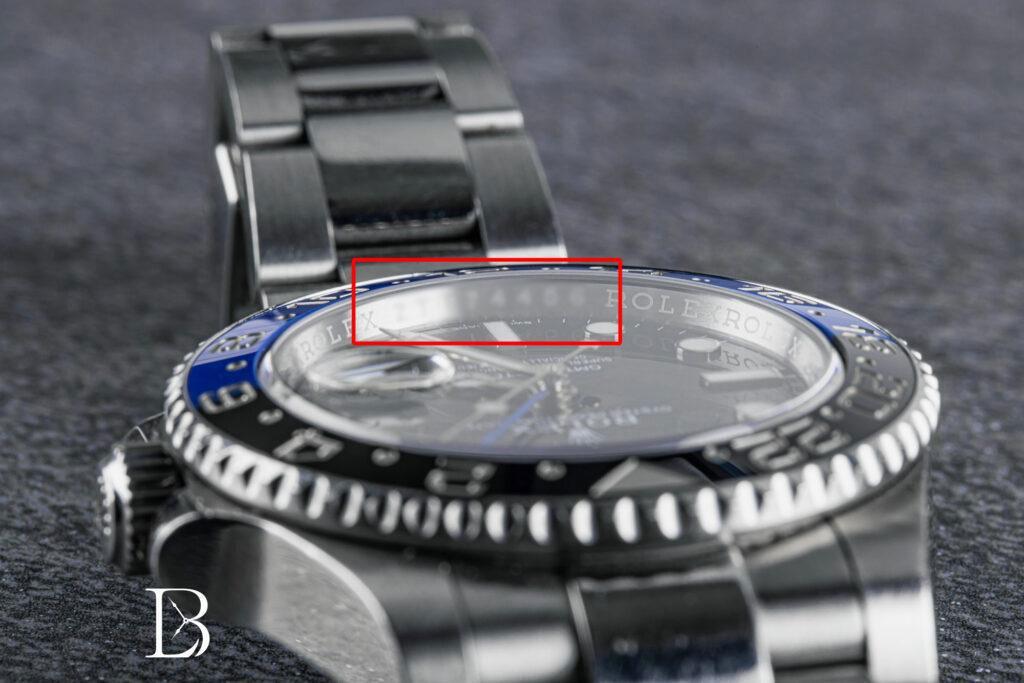
Real Rolex rehauts aren’t always aligned perfectly, but they should be close. The minute lines might not exactly bisect each letter, but if any minute line is so far off that it’s not even touching a letter, that’s a pretty conclusive sign of a fake.
Rehaut engravings on Real Rolexes have a clean, sandblasted appearance. Low-quality etching is indicative of a counterfeit.
Before the engraved rehauts, Rolex serial numbers were engraved on the case between the bottom lugs. Fakes often have poorly-engraved serials, or none at all.
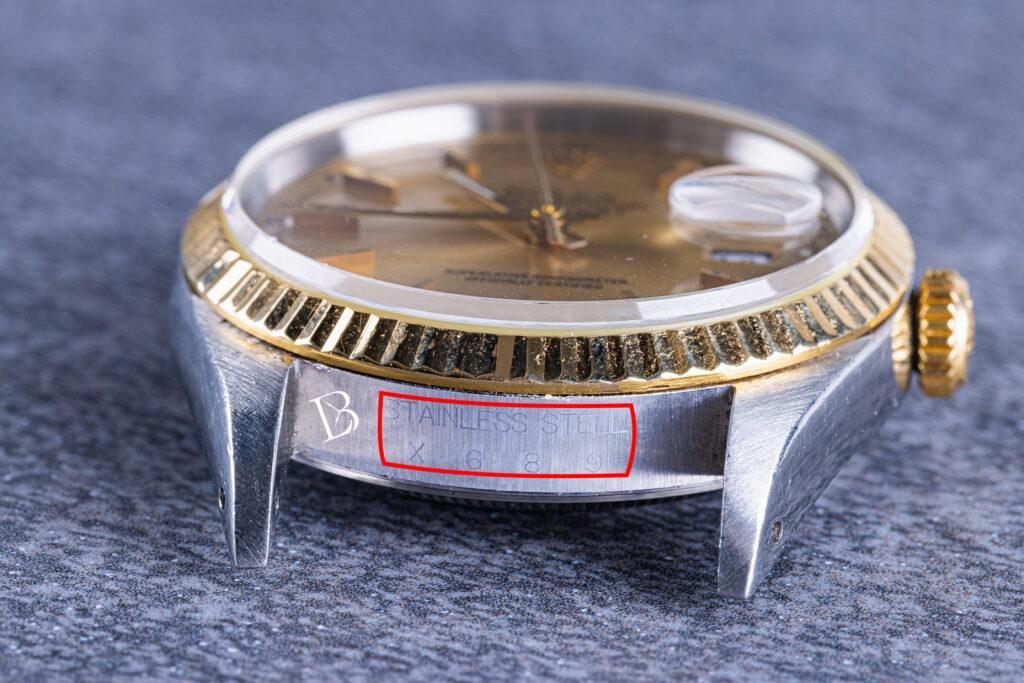
Dial stampings
As with the serial number, the stampings on the front of a fake Rolex may look faded, uneven or even misspelled. In this macro shot of a ref. 116500 Daytona, we can see crisp, glossy, slightly raised lettering:
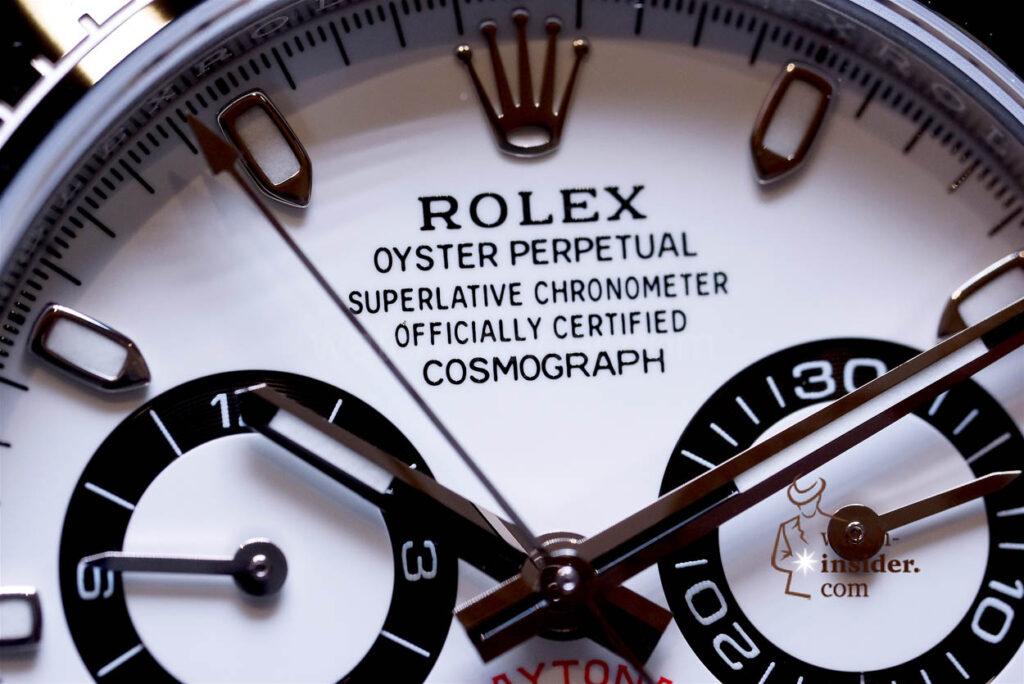
Even these modern “high-end” fakes have lettering with a more flat, painted-on appearance:

For a Deep Dive into Rolex Dials: Guide to Every Special Rolex Dial
Laser-etched coronet (“LEC”)
From 2002 onward, Rolex started engraving the crystal with a tiny crown logo next to the 6 o’clock mark as an anti-counterfeiting measure. Counterfeiters often fake this, but they make it too visible, so counterintuitively, seeing this laser-etched coronet in photos is actually a red flag. A skilled photographer can capture a real LEC with the right lighting though, as shown below, and legit LEC’s are more pointillated and less “foggy” than fake ones.
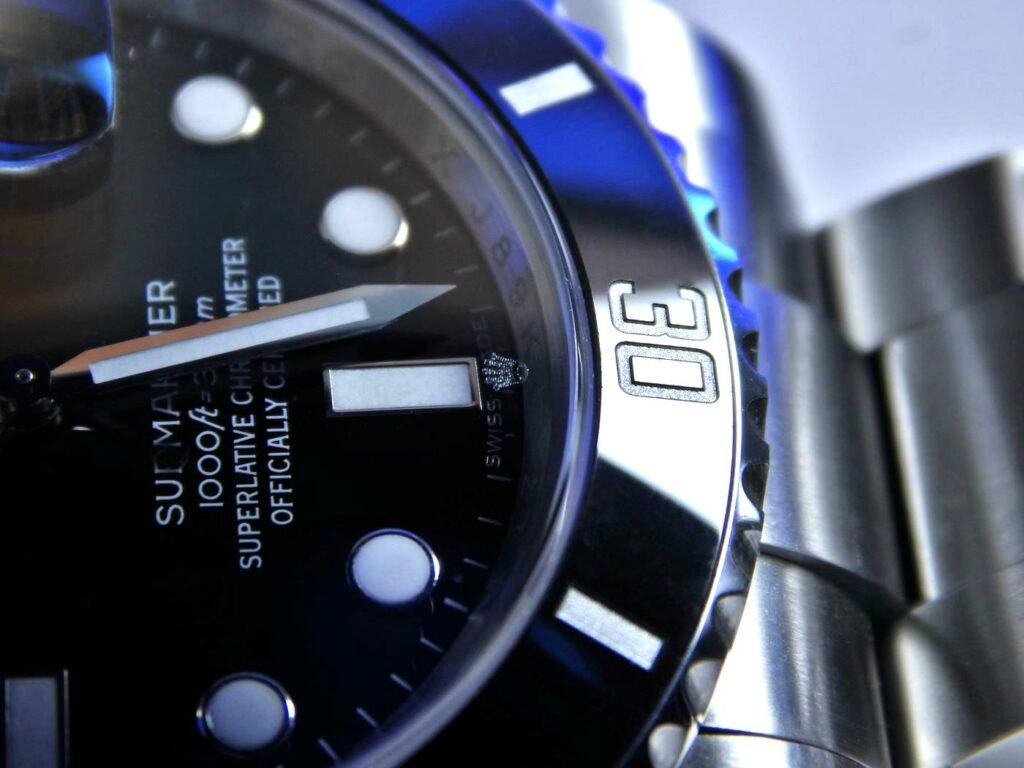
Weight and materials
Rolex watches are made with high quality materials, and their modern bracelets are quite heavy. Fakes often use cheap materials, leading to a much lighter watch. However, it should be noted that vintage Rolexes are far lighter than new ones, and owners of modern Rolexes sometimes (wrongly) assume old Rolexes are fake because of their lack of heft.
Rolex uses solid 18k gold in its gold and two-tone watches. Fakes often use cheap gold plating, so any sign of gold plating rubbing off is almost always indicative of a fake.
Bezel feel
Rotating a Submariner bezel results in smooth, subtle clicks. It feels noticeably better than bezels on cheap divers. Modern GMT-Master II models have spring-loaded ball bearings underneath their bezels, resulting in a smooth, satisfying rotating action. If you’re not sure if the Sub or GMT in your hands is legit, give the bezel a spin and see if it feels “cheap.”
Know the model you’re looking at
Ultimately, one of the best ways to spot a fake is by knowing what a real version of that particular model looks like. If you’re looking at a Submariner Date, try to figure out if it’s a 16610 or 116610 etc. and know the characteristics of each.
Knowing the reference number helps you know what the watch should look like. For example, if you’re looking at a Sea-Dweller manufactured before 2017, it should not have a cyclops. Ref. 126600 was the first Sea-Dweller with a cyclops. In general, a Rolex sales listing without a proper model number is a red flag.
See it on the Wrist: The 126600 Sea-Dweller
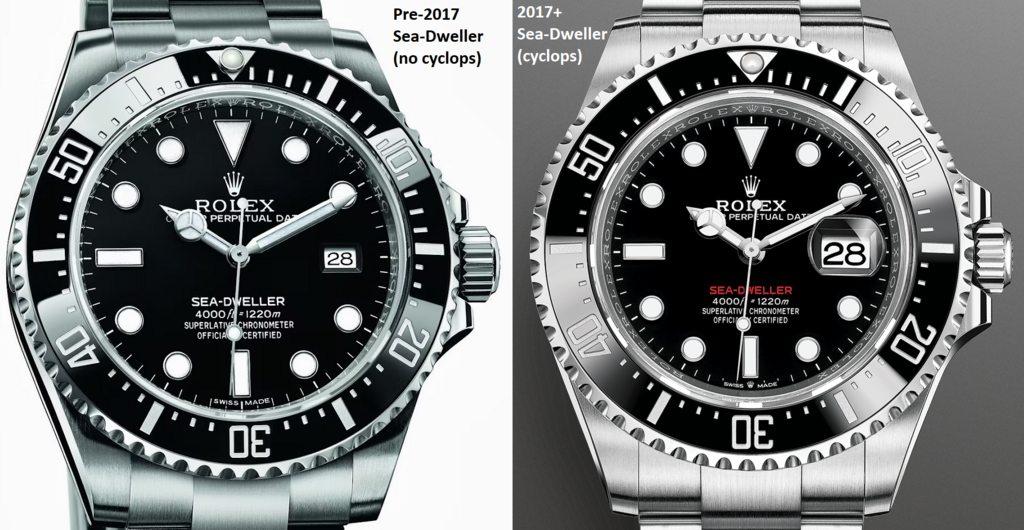
Basic indicators of age: Do they match up?
Even within a single reference, Rolex has been known to produce several variations. For ref. 16610 Submariner Date models, for example, solid end links (“SEL”) replaced hollow end links (“HEL”) around 2000. The SEL’s aren’t really that much more solid than “hollow” ones (“slightly reinforced” might be more accurate, as you can see below). However, collectors almost universally agree that the SEL’s indeed feel significantly more solid than the HEL’s, which have their own lightweight charm.
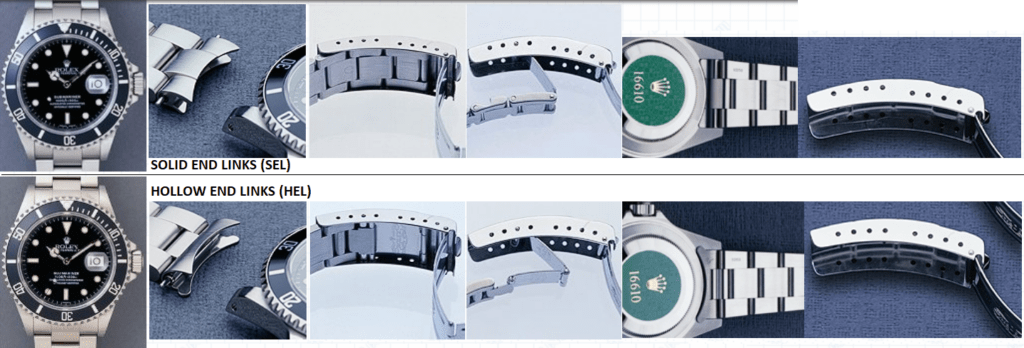
Knowing what hollow end links look like, and when they were phased out, is helpful when assessing the age and legitimacy of a “Rolex” watch. Let’s go over a timeline of useful Rolex milestones to know:
Notable changes in recent decades
| 1997-2000: Tritium phased out | Modern non-radioactive lume began to replace tritium in the Rolex lineup in 1997. If you see a watch that looks like a Rolex that came out in 2012, but it says “T SWISS T” at the bottom, it’s fake. |
| 2000 – Solid end links debuted | As mentioned, the Sub Date got SEL’s in 2000, and they were added to the rest of the lineup in the following years. |
| 2002 – Lugholes disappearing | Lugholes were removed from Sub Dates and GMT’s around 2002. If you see a 16610T or 16710T model, just remember the “T” as being short for “there’s no lugholes!” 5-digit no-date Submariners kept their lugholes until the end, though; 14060m was the final Rolex model with lugholes. |
| 2002 – Laser-etched coronet | The LEC also began appearing around 2002. So if you see a 1970’s model with the LEC, for instance, run away. Note that the Milgauss GV, with its green sapphire crystal, has no LEC. |
| 2004-2008 – Engraved rehaut debuts | The engraved rehaut first appeared on some Turn-O-Graph models in 2004, but it wasn’t commonly seen until 2005 and it wasn’t on the entire lineup until 2008. |
| 2006 – No more caseback stickers | Since 2006, Rolexes no longer come with green stickers on the casebacks. |
Made in USA? On a Rolex?
One might think that “U.S.A” stampings on the bracelet of a Swiss watch would be a red flag, but from about 1959-1979, Rolex frequently used locally-sourced bracelets. Complete watches were often taxed more heavily than incomplete ones, which is why you can find real vintage Rolex bracelets made in the U.S.A, as well as Mexico, Japan, and South America. Nowadays, Rolex’s supply chain is more vertically integrated and entirely Swiss-made.
Learn More: Overview of the Rolex Supply Chain
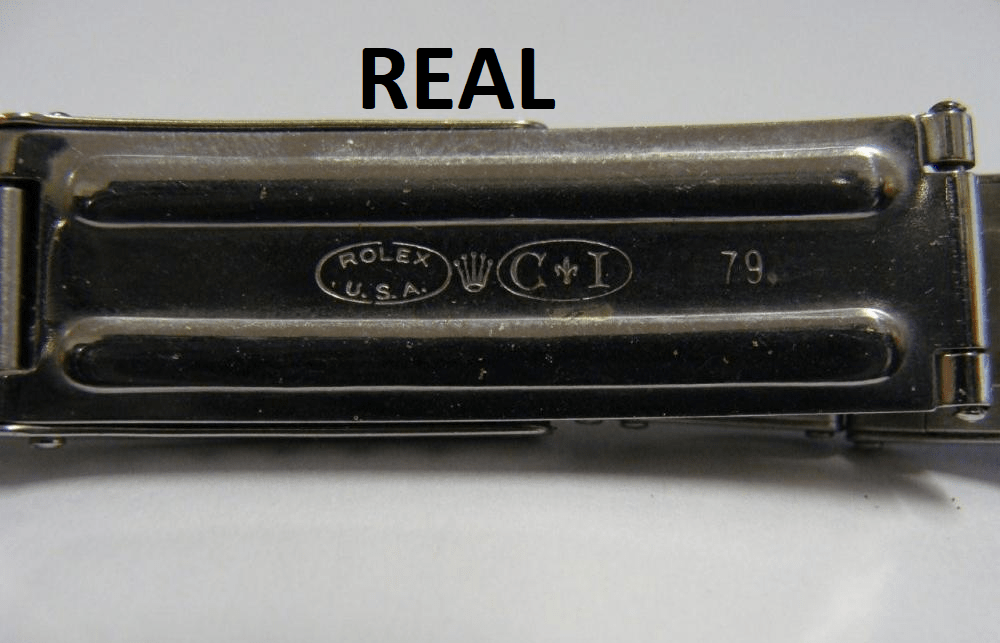
Common Fake Rolex Tells
Low-quality/mismatched engravings
Some fake clasps are pretty convincing these days, but let’s tackle one that can be pretty quickly dismissed. A quick search of “62523H” reveals that code belongs on a two-tone Jubilee bracelet, not a steel Oyster. The low-quality black writing, combined with the poor embossing of the Rolex logo, are more signs of a fake.
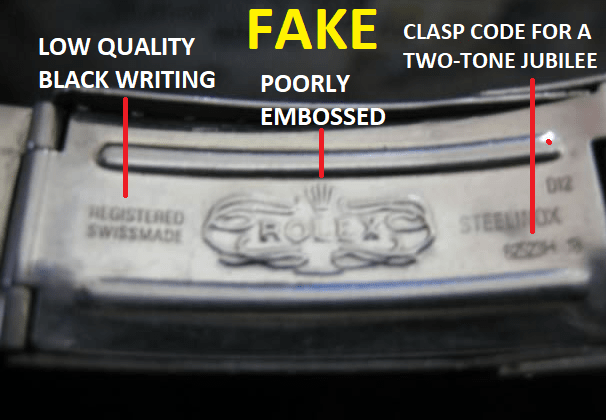
ebay Marconis
Marconi was an early brand of the Rolex Watch Co. and you can find some real Rolex Marconi watches from the 1920’s, but the Rolex Marconis that litter the landscape of ebay (usually in the $1,000-$1,500 price range) are almost entirely fakes. They are hodgepodges of old watch parts with a “Rolex Marconi” stamp added to the dial, often found in South America and Japan. Stay away from watches that look like this:
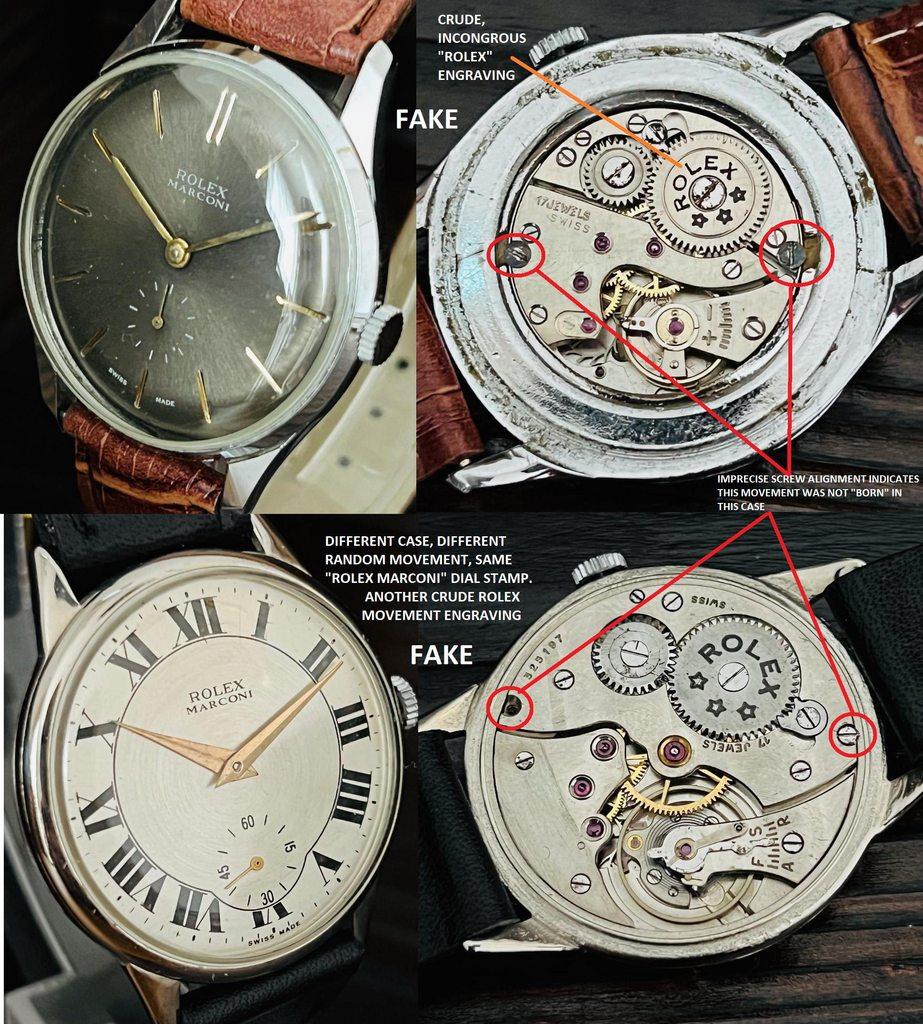
Cheap buckles
While you’re avoiding ebay Marconis, go ahead and skip ebay Rolex buckles too. Fake Rolex buckles are so common that it’s healthy to be skeptical if you get one anywhere except a Rolex Service Center. Often, gold-plated fake buckles will say “ACIERINOX” which, humorously enough, means “stainless steel.” Real gold-plated vintage Rolex buckles do exist but they say “PLAQUE.”
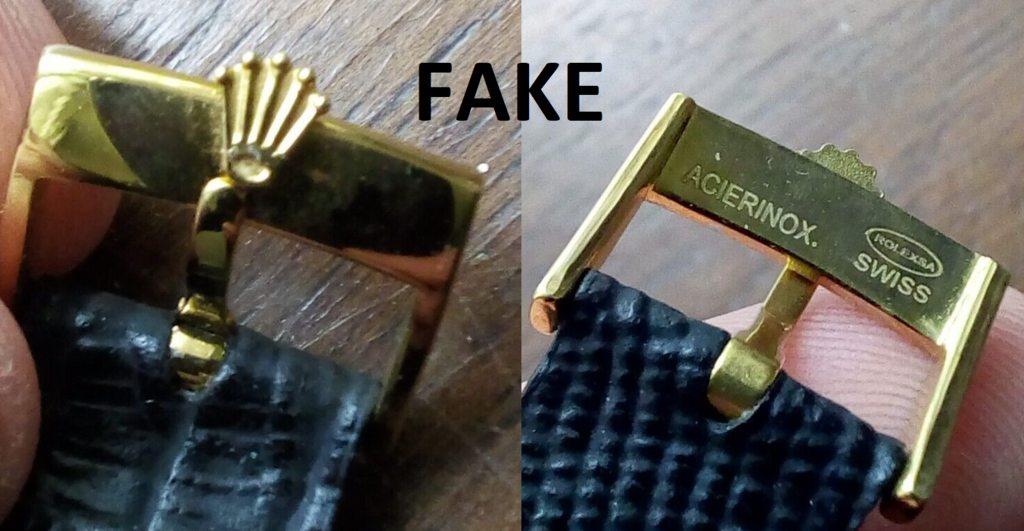
Here’s an example of a genuine vintage gold-plated Rolex buckle:
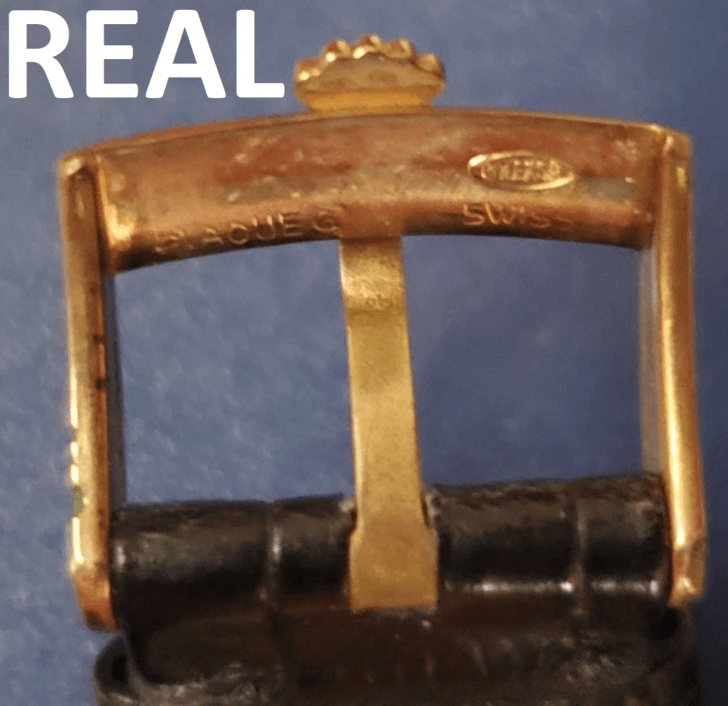
Shrink wrap
While it is theoretically possible for resellers of genuine Rolexes to wrap their watches in plastic, it’s not a common practice. Seeing the lugs wrapped in this stupid shrink wrap is a huge red flag, and often “904L” will be written in red:

LEC that’s too easy to see
We’ve shown you an example of a legit laser-etched coronet above. Now here’s a typical fake LEC:
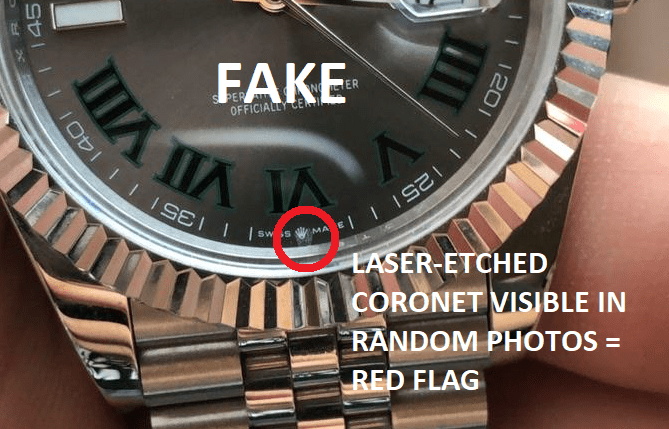
Iffy fluted bezels, wonky rehauts
Real fluted Rolex bezels are made of solid gold, and they are extremely shiny. The fluted bezels of stainless steel fakes often show smudges and fingerprints more than a real one would. On this same fake Rolex we can also see the poor rehaut alignment mentioned earlier. Minute markers should each go through a letter of the word “ROLEX” and although even real ones are often aligned imperfectly, the spacing won’t be this wonky:
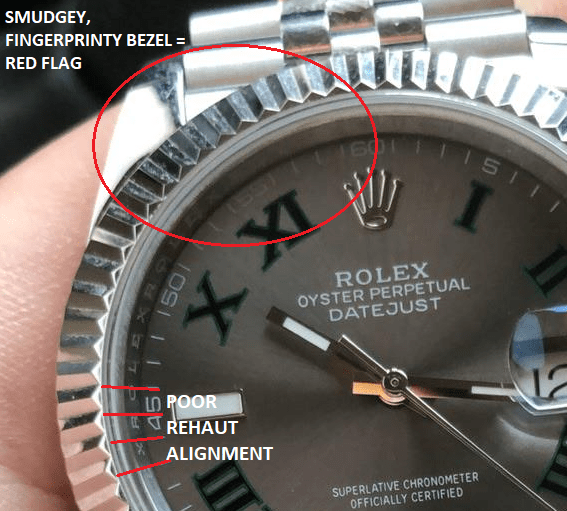
“Quartz” on the dial
Aside from the rare ref. 5100 prototypes, Rolexes never say “Quartz” on the dial unless it’s part of the word “Oysterquartz.” This tip can be useful when scrounging through estate sales or Goodwill, so you can quickly disregard watches such as this:
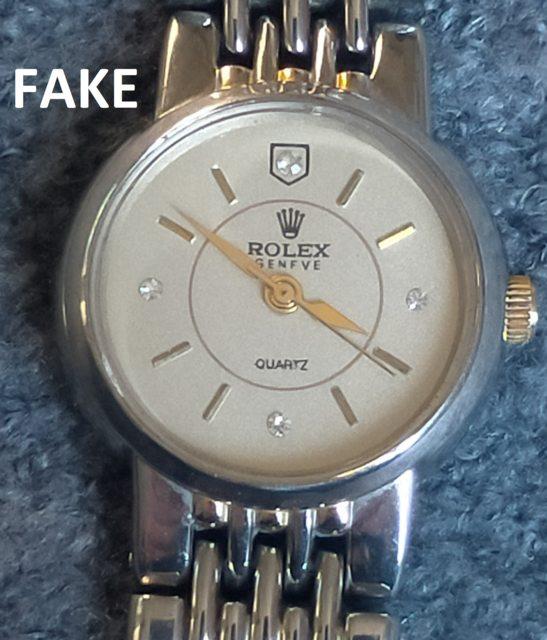
Cellinis with date windows or lume
Rolex has never put lume, nor a date window, on any of their Cellini models. Watches like this can also be quickly dismissed:
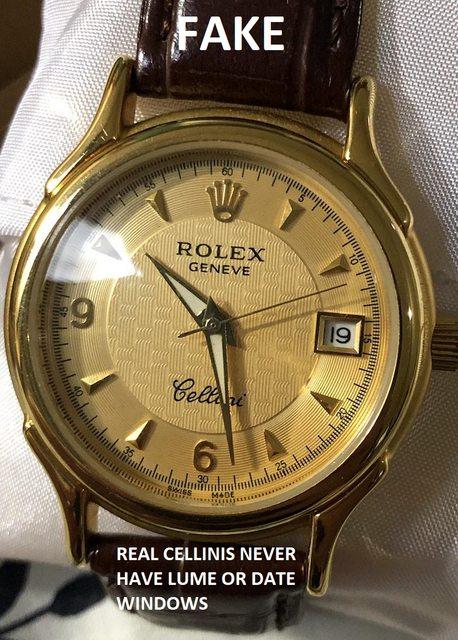
Tudor date fonts on a “Rolex”
Vintage Tudor watches have several parts that are similar (and often interchangeable) to those of their Rolex counterparts. However, Tudors have their own distinctive date fonts. Sometimes, counterfeiters will use a mix of counterfeit, Tudor, and Rolex parts. Since many Tudors use ETA movements, and many fakes do too, it’s easy for fakers to use Tudor date wheels. If you recognize the Tudor date font on a so-called “Rolex,” that’s likely a “franken” like the watch below:
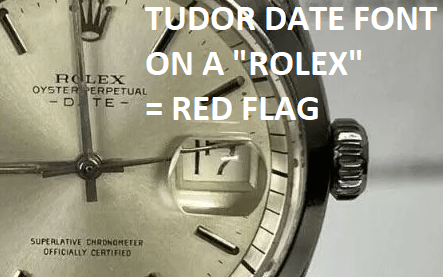
Lumed hands on an unlumed dial
With few exceptions, if a Rolex has no lume on the dial, it shouldn’t have lume on the hands, either. Sometimes collectors and resellers of genuine Rolexes do “dial swaps” and forget to match the hands, but in general, lumed hands on an unlumed dial are a red flag.
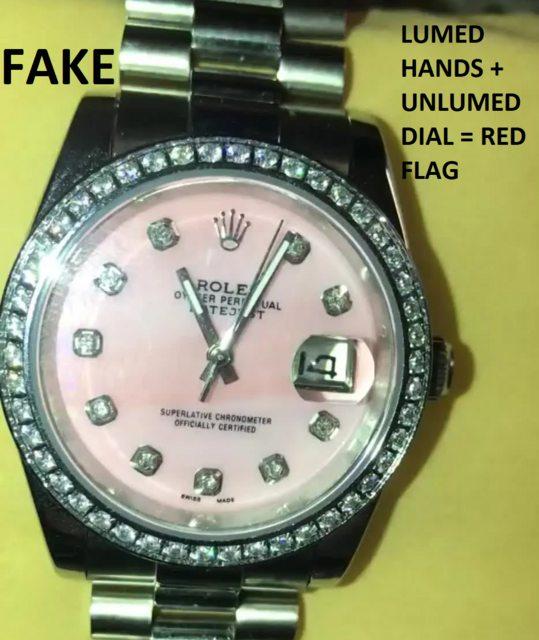
Two-tone Day-Dates
Rolex never made a steel-and-gold Day-Date. Two-tone “Day-Dates” like the one below are some of the most common fakes around:
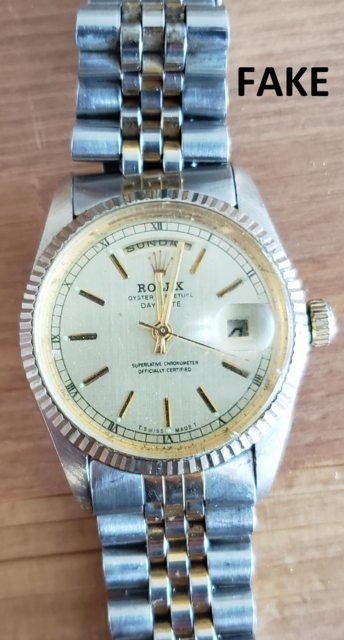
Gold plating rubbing off
Although some obscure gold-plated vintage Rolex models (like 3386, 1550, 1024 etc.) do exist, Rolex has never used gold plating on any sports model, Day-Date, or Datejust. If you see gold plating that has rubbed off on these models, stay away.
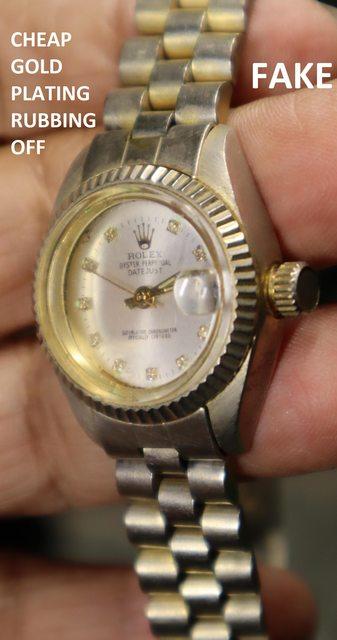
Although the accuracy of counterfeiters is only going to get scarier and scarier, if you keep these guidelines in mind, you should be able to spot most of the fake Rolexes on the market today. Just remember to research the model you’re purchasing, and that there’s no substitute for buying from a trusted, reputable dealer!
More Rolex Guides from Grey Market:
Rolex Serial Numbers: The Ultimate Guide
How Many Links Does a Rolex Come With?
How Does The Rolex Waiting List Work? Can it Be Avoided?
Breaking Down Rolex Prices: Retail vs. Actual Market for Top Models


1 Comment
This information is valuable for future Rolex owners.